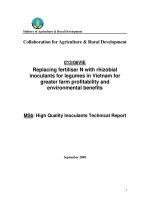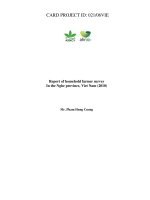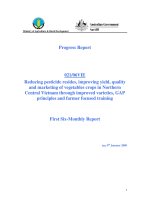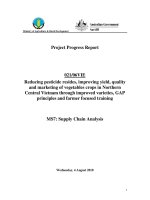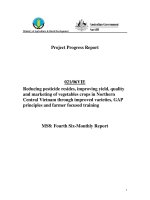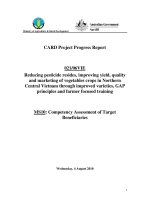Báo cáo khoa học nông nghiệp " An Integrated Production, Distribution and Marketing Plan for Melon and Cabbage In Vinh Province, Vietnam " pot
Bạn đang xem bản rút gọn của tài liệu. Xem và tải ngay bản đầy đủ của tài liệu tại đây (32.67 KB, 3 trang )
An Integrated Production, Distribution and Marketing Plan
for
Melon and Cabbage
In
Vinh Province, Vietnam
Background:
A collaborative project between researchers and farmers in Vinh Province of
Vietnam and Applied Horticultural Research in Australia aims to improve the
income of smallholders by encouraging adoption of clean and sustainable
production practices.
Components of the project include:
• Reducing pesticide residues and
• Improving yield, quality and marketing of Cucurbit and Brassica vegetable
crops in Northern Central Vietnam through:
Improved varieties,
GAP principles and
Farmer focussed training.
Major activities include:
1. New melon and cabbage products being marketed to consumers, initially
through Metro Cash & Carry Vietnam.
2. New technology developed, tested and documented on how to produce
melons and cabbage in Vinh Province.
3. Improved links between the industry, research and extension organisations
involved in the project.
4. Two scientists from Vietnam trained in Australia in the production of melons
and cabbage.
To maximize the benefits of the programme to farmers in Vinh Province, an
integrated production, distribution and marketing plan is proposed, based on the
melon and cabbage product specifications nominated by retailer Metro Cash &
Carry Vietnam.
Some Components of the Plan:
INTEGRATED PRODUCTION AND MARKETING PLAN
PRODUCTION DISTRIBUTION SALES & MARKETING
Product Specifications Packaging Sales Coordination
Production Systems Transport Branding
Harvest/Post Harvest Promotion
Quality/Food Safety Training Communication Participation
PRODUCTION:
1. Product Specifications – supplied by Metro Cash & Carry Vietnam
2. Production systems, incorporated in a Good Agricultural Practice (GAP)
Manual and including:
a. New Varieties
b. Crop scheduling
c. Water management
d. Crop nutrition
e. Pest and disease management
3. Harvest/ Post Harvest practices, incorporated in GAP Manual
a. Harvest maturity
b. Harvest scheduling
c. Temperature management
d. Grading and packing
DISTRIBUTION:
1. Packaging
a. Carton selection best suited to each product
b. Efficient packing in cartons
c. Stacking for transport
2. Transport
a. Maintaining ‘cool chain’
b. Minimizing damage – rice straw etc
c. Reliable delivery
3. Supply Chain Links
a. ASINCV, RIVAF and province level MARD extension centre and
district level extension station staff
b. Growers and
c. Retailer
SALES & MARKETING:
1. Sales Coordination
a. Establish sales and marketing structure - cooperative
b. Select and appoint sales coordinator
2. Branding
a. Cartons
b. Individual products e.g.
i. Labels on melons
ii. Ties on cabbage
c. Retail materials – posters, leaflets
3. Promotion
a. In-store (Metro)
i. Posters, leaflets etc (branded)
ii. In-store sampling
iii. Metro staff education
b. Food service customers – tourist hotels and restaurants
c. Trade e.g. ‘Asiafruit’ magazine
QUALITY/FOOD SAFETY:
Document in GAP Manual and communicate to farmers/suppliers (including
training)
1. Quality standards required, based on Metro specifications
2. Food safety requirements, based on international standards
TRAINING:
ASINCV and RIFAV:
• Field trials - training on experimental design and management
• ELISA system to test for pesticide residues
• Mapping supply chain to determine areas for improvement
• Marketing
• Fresh Care Quality Assurance system
Farmers:
• Farmer Field Schools
• Field trials
• Preparation of GAP manuals
• IPM
• Post harvest
• Marketing
• QA system
COMMUNICATION:
Establish communication networks between farmers, researchers, AHR, Metro and
their customers.
PARTICIPATION:
1. Identify farmers interested in participation
2. Establish structure to coordinate supply in Vinh and sales and marketing
programme.
Produce Marketing Australia
August 2007

